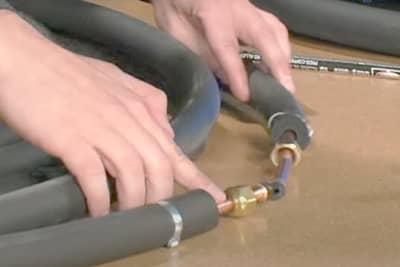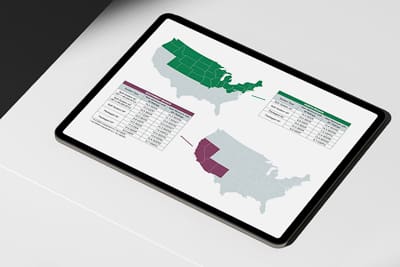INFLATION REDUCTION ACT OF 2022
ENERGY EFFICIENCY INCENTIVES FOR HVAC SYSTEMS
Copyright 2022 Alpine Home Air

The Inflation Reduction Act (IRA) that became enrolled law on August 16, 2022 provides several incentives for homeowners, building owners, and contractors for installing or upgrading heating and cooling systems to higher energy efficient systems in an effort to reduce greenhouse gas emissions.
In addition to a previously enacted nonbusiness energy property tax credit, there are three major components of the new law that taxpayers may take advantage of. The new benefits will not be available until January 1, 2023 and the US Department of Energy still needs to sort out how the application process will work and how funds will be distributed to each State office. Combining these rebate programs is not allowed and there are several limitations for each to be aware of. Below is a brief description of each:
- “High-Efficiency Electric Home Rebate Program” provides cash rebates for new equipment installations and upgrades with household income level limitations.
- “Home Owner Managing Energy Savings (HOMES) Rebate Program” provides greater incentives for whole-house projects with household income level limitations.
- “Energy Efficient Home Improvement Tax Credit (Section 25C)” provides tax credits for installed equipment that exceeds CEE’s highest tier (not the advanced tier) and has no income level limitations.
- Additionally there is a Home Energy Audit tax credit for up to $150 for a taxpayer’s principal residence
- “Nonbusiness energy property” tax credit, a previous law under Section 25C, is extended to December 31, 2032 for property placed in service after December 31, 2021.
High-Efficiency Electric Home Rebate Program
The most applicable program to most homeowners is the “High-Efficiency Electric Home Rebate Program” (HEEH). The rebate caps are as follows:
- Program Qualification Dates: To be determined; the policy provisions to implement HEEHRA are not yet in place. Federal agencies including the IRS, EPA, and DOE will create the rules and regulations for distributing the money but the individual states will be directly involved in implementing the program.
- Maximum combined rebate is $14,000
- Amount of rebate per qualified household:
- Energy Star certified appliance upgrades under a qualified electrification project:
- Up to $8,000 for heat pump for space heating and cooling
- Non-appliance upgrades under a qualified electrification project:
- Up to $4,000 for an electric load service center upgrade
- Up to $1,600 for insulation, air sealing, and ventilation
- Up to $2,500 for electrical wiring
- Purchased of an appliance / non-appliance under a qualified electrification project
- Energy Star certified appliance upgrades under a qualified electrification project:
Limitations are primarily based on income level favoring low- and moderate-income households. This is based on the area median income (AMI) for where the property is located and can be found by entering an address at this calculator, which will inform the user of what the 80% and 100% area median income is for that area. To calculate the 150% threshold, simply multiply the 100% value by 1.5. That will provide the maximum household income that would qualify for the rebate program. The amount of the rebate is graduated by the income level as follows:
- For a low- or moderate-income household:
- If your household income is below 80% of the area median income, then 100% of the system purchase price qualifies for the rebate.
- If your household income is between 80% and 150% of the area median income, then 50% of the system purchase price qualifies for the rebate.
- If your household income is greater than 150% of the area median income, then you are not eligible for the rebate.
- For an individual or entity that owns a multifamily building not less than 50 percent of the residents of which are low- or moderate-income households:
- 50% of the cost of the qualified electrification project for a multi-family building is not less than 50% of the residents that are households with an annual income between 80% and 150% of the area median income.
- 100% of the cost of the qualified electrification project for a multifamily building is not less than 50% of the residents that are households with an annual income less than 80% of the area median income.
- For a governmental, commercial, or nonprofit entity, as determined by the Secretary, carrying out a qualified electrification project on behalf of an entity described as:
- 50% of the cost of the qualified electrification project for a household where the eligible entity is working and the annual income is between 80% and 150% of the area median income.
- 100% of the cost of the qualified electrification project for a household where the eligible entity is working and the annual income is less than 80% of the area median income.
For heating and cooling systems, a “qualified electrification projects” means:
- Purchase and installation of:
- An electric heat pump for space heating and cooling
- An electric load service center
- Insulation
- Air sealing and materials to improve ventilation
- Electric wiring
- The project may be:
- Part of new construction
- Replaces a non-electric appliance (e.g. gas, oil, or coal)
- A first-time purchase with respect to the appliance
- Appliance, system, equipment, infrastructure, component, or other related item must be certified under the Energy Star program.
- The project is carried out at, or relating to, a single-family home or multifamily building, as applicable and defined by the Secretary.
Sources:
- 42 U.S.C. § 18795a: High-efficiency electric home rebate program
- IRA Homeowner’s Calculator
- Understanding The High Efficiency Electric Home Rebate Act (HEEH)
- Consumer Reports Article
- CEE 2023 Specification Standards
Home Owner Managing Energy Savings (HOMES) Rebate Program
The “HOMES Rebate Program” provides rebates for whole-house energy saving retrofits that started on or after August 16, 2022 and are completed by September 30, 2031. Similar to the “High-Efficiency Electric Home Rebate Program”, the amount of the rebate is determined by the household income level in relation to the area median income. This program bases the rebate on either modeled or measured energy savings. The rebate caps are as follows:
For single-family homeowners:
- The lesser of either $2,000 or 50% of the project cost for a retrofit that achieves modeled energy system savings between 20% and 35%.
- The lesser of either $4,000 or 50% of the project cost for a retrofit that achieves modeled energy system savings over 35%.
- For measured energy savings:
- Must achieve energy savings at or above 15% and either:
- A payment rate per kilowatt hour saved, or kilowatt hour-equivalent saved, equal to $2,000 for a 20% reduction of energy use for the average home in the State; OR
- 50% of the project cost
- Must achieve energy savings at or above 15% and either:
For multi-family building owners:
- $2,000 per dwelling unit with a maximum of $200,000 per multi-family building for a retrofit that achieves modeled energy system savings between 20% and 35%.
- $4,000 per dwelling unit with a maximum of $400,000 per multi-family building for a retrofit that achieves modeled energy system savings greater than 35%.
- For measured energy savings:
- Must achieve energy savings at or above 15% and either:
- A payment rate per kilowatt hour saved, or kilowatt hour-equivalent saved, equal to $2,000 for a 20% reduction of energy use per dwelling unit for the average multi-family building in the State; OR
- 50% of the project cost
- Must achieve energy savings at or above 15% and either:
For single-family or multi-family owners with homes/dwelling units occupied by a low- or moderate-income household (greater than 50% for multi-family):
- The lesser of either $4,000 per single-family home or dwelling unit or 80% of the project cost for a retrofit that achieves modeled energy system savings between 20% and 35%.
- The lesser of either $8,000 per single-family home or dwelling unit or 80% of the project cost for a retrofit that achieves modeled energy system savings over 35%.
- For measured energy savings:
- Must achieve energy savings at or above 15% and either:
- A payment rate per kilowatt hour saved, or kilowatt hour-equivalent saved, equal to $2,000 for a 20% reduction of energy use per single-family home or dwelling unit, as applicable, for the average single-family home or multi-family building in the State; OR
- 80% of the project cost
- Must achieve energy savings at or above 15% and either:
Sources:
- 42 U.S.C. § 18795: Home energy performance-based, whole-house rebates
- IRA Homeowner’s Calculator
- Consumer Reports Article
- CEE 2023 Specification Standards
Energy Efficient Home Improvement Tax Credit (Section 25C)
The Energy Efficient Home Improvement Tax Credit is an existing tax credit for installing heating and cooling systems that exceed the Energy Star requirements and installed at the taxpayer’s principal residence. This tax credit is available for all income levels. The current program under Section 25C was extended to December 31, 2032 for property placed in service after December 31, 2021. The updated credit program applies to property placed in service after December 31,
2022. Any property placed after December 31, 2024 will require the manufacturer to supply a serial number. The credits will be available until 2032.
- For individuals, a tax credit within the given tax year may occur equal to 30% of the sum of:
- The amount paid or incurred by the taxpayer for qualified energy efficiency improvements installed during such taxable year,
- The amount of the residential energy property expenditures paid or incurred by the taxpayer during such taxable year, and
- The amount paid or incurred by the taxpayer during the taxable year for home energy audits.
- Tax Credit equal to 30% of costs incurred up to:
- $1,200 annually including:
- $600 for eligible air conditioners
- $600 for eligible furnaces
- $600 for eligible A natural gas, propane, or oil furnace or hot water boiler
- $2,000 annually for purchase of electric heat pumps
- Up to $150 for Home Energy Audit for a taxpayer’s principal residence the provides the following:
- Identifies the most significant and cost-effective energy efficiency improvements with respect to such dwelling unit, including an estimate of the energy and cost savings with respect to each such improvement
- Conducted and prepared by a home energy auditor that meets the certification or other requirements specified by the Secretary in regulations or other guidance (as prescribed by the Secretary not later than 365 days after the date of the enactment of this subsection).
- $1,200 annually including:
- Income requirements:
- None.
- Combining programs:
- Cannot use with the “High-Efficiency Electric Home Rebate Program”
- May be eligible to combine with local or utility rebate programs.
Sources:
- 26 U.S.C. § 25C: Energy efficient home improvement credit
- IRA Homeowner’s Calculator
- Consumer Reports Article
- CEE 2023 Specification Standards
- Dept. of Energy Tax Credit Guide and FAQs
Nonbusiness Energy Property Tax Credit (previously enacted program)
The previous program that is now replaced by the Inflation Reduction Act of 2022 and is now effective to December 31, 2032 for property placed in service after December 31, 2021. While waiting for the new incentives to go into effect beginning January 1, 2023, households are able to receive up to a $300 tax credit now for the current tax year (2022). The total of current and previous years credits after 2005 for this program, including those for energy efficiency improvements, high efficiency furnace and air conditioner cannot exceed $500 (lifetime limitation).
The tax credit for an individual, for the tax year the item was purchased, is calculated as the sum of 10% of the amount paid or incurred by the taxpayer for qualified energy efficiency improvements installed AND the amount of residential energy property expenditures paid or incurred by the taxpayer during such a taxable year.
A “qualified energy property” can be:
- An electric heat pump that achieves the highest efficiency tier established by the Consortium for Energy Efficiency, as in effect on January 1, 2009 – 15 SEER or higher for split systems and 14 SEER for packaged unit heat pumps.
- A central air conditioner that achieves the highest efficiency tier established by the Consortium for Energy Efficiency, as in effect on January 1, 2009.
- A qualified natural gas, propane, or oil furnace or hot water boiler that achieves an annual fuel utilization efficiency rate of 95 or higher, OR
- An advanced main circulating fan that is used in a natural gas, propane, or oil furnace that has an annual electricity use of no more than 2% of the total annual energy use of the furnace (as determined by the standard Department of Energy test procedures).
This tax credit does not apply to new construction or rental properties. Must be the taxpayer’s principal residence.
Applying For Tax Credits or Rebates
For the tax credits, you’d claim them on your federal income tax returns. We’re not yet sure which form you’ll need to complete, but in previous years, IRS Form 5695 was used for a similar residential energy credits program. A good tax preparer will know what to use, and programs like TurboTax often guide you in a way that makes it easy to claim relevant tax credits. The rebate programs will vary from state to state, and are still to be determined. They could potentially be implemented through utility companies, or through state-run agencies. There is a line in the bill that encourages the Department of Energy (DOE) and state programs to work together to make the rebates accessible at the point of sale—building it into the out-of-pocket cost for consumers.
Sources:


